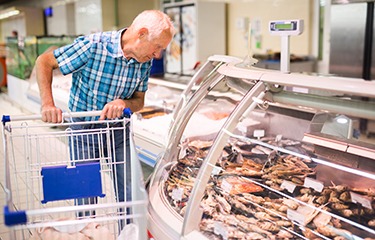Shelf-stable seafood sales continued to increase in value at U.S. grocery stores despite the highest price increases of any seafood category.
Shelf-stable seafood sales rose 6.2 percent to USD 188 million (EUR 178 million) for the four weeks ending 27 November, according to new data from IRI and 210 Analytics. At the same time, inflation on canned and pouched seafood jumped 12.4 percent.
“People are pulling back on how much they buy, but in terms of dollars, are collectively still spending more on canned tuna and other shelf-stable items," 210 Analytics Principal Anne-Marie Roerink told SeafoodSource. "Despite inflation, shelf-stable seafood is still a great value compared with fresh or frozen seafood, meat, and poultry."
Cumulative frozen seafood sales plummeted 4.5 percent to USD 438 million (EUR 412 million), while prices jumped 7.6 percent.
“Frozen has seen above-average inflation across all categories. There’s really not any one area in frozen that has inflation below that of total food and beverages,” Roerink said. "So, it is likely the overarching supply-chain challenges, including transportation, that is plaguing the total category.”
Frozen salmon sales jumped 13.5 percent, frozen pollock sales climbed 8.7 percent, and frozen crab sales rose 6.2 percent. Fresh seafood sales realized a less dramatic sales decline of 1.7 percent to USD 489 million (EUR 460 million), with fresh seafood prices rising 2.9 percent for the month.
“The deceleration of inflation is promising for seafood, and we certainly are seeing some improvement in volume sales in the big sellers. Fresh salmon had dipped into negative sales there for a minute but is back up and a few others are looking better, too,” Roerink said.
Fresh salmon prices rose 2.2 percent to USD 10.32 (EUR 9.72) per pound on average, while shrimp prices rose 7.6 percent to USD 9.29 (EUR 8.75) a pound. Conversely, fresh crab prices dropped 17.6 percent to USD 10.24 (EUR 9.64) per pound on average in the time period. Fresh finfish prices rose 7.5 percent, compared to a 3.5 percent average price drop for shellfish. Shellfish sales declined 12 percent, compared to an increase of 1.5 percent for fresh finfish.
During Thanksgiving week, fresh seafood sales dropped by around USD 10 million (EUR 9.4 million), according to Roerink, though she said "America’s focus was on meat" over the holiday.
Inflation continues to impact sales across many food and beverage categories. Inflation at grocery stores, supercenters, club stores, and mass market stores soared 13.6 percent in November, which is nearly unchanged from the 13.7 percent increase in October, according to 210 Analytics.
Compared to November 2019, prices across the larger food and beverage category jumped 28.7 percent.
The U.S. Bureau of Labor Statistics’ November Consumer Price Index shows that food at home costs soared 12 percent compared to November 2021, and rose 0.5 percent from October to November. Food away from home costs rose 8.5 percent compared to last November, and 0.5 percent compared to last month.
Overall fish and seafood prices dropped 0.1 percent in November, compared to November 2021, the CPI showed.
Consumers continue to change their buying and eating habits as a result of inflation, according to both IRI and a new survey from retail technology platform Swiftly. Americans are moving to dishes that help “stretch” the protein dollar, which is boosting sales of shelf-stable seafood, Roerink said.
“Think ground beef in a meat sauce with some mushrooms instead of center-of-plate burgers. You may not need as much and can bring down the cost of the total meal. The same is true for meals such as tuna casserole or tuna salad sandwiches: They are still very cost-favorable,” Roerink said.
Nearly 70 percent of Americans surveyed by Swiftly are struggling to pay their grocery bills, and 24 percent said they are likely to reduce meat purchases due to inflation, the retail technology platform firm said in a press release and via Supermarket News.
For the holiday season, 35 percent said they are planning to make fewer dishes and 24 percent said they are adjusting some of their entrées. Another 24 percent said they are cooking with others to share the cost burden, and 10 percent are planning to eat more vegetarian food.
Photo courtesy of Caftor/Shutterstock







